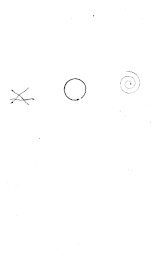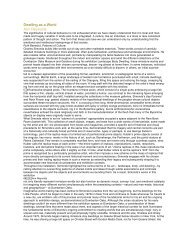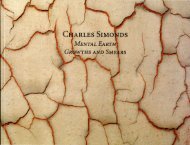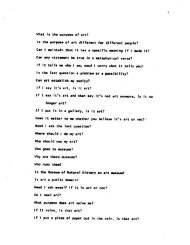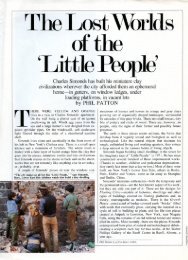Read Catalog - Charles Simonds
Read Catalog - Charles Simonds
Read Catalog - Charles Simonds
Create successful ePaper yourself
Turn your PDF publications into a flip-book with our unique Google optimized e-Paper software.
Circles and Towers Growing<br />
This series traces a possible and fairly comprehensive evolution<br />
of the Little People's world and their usc of it through ritual<br />
and architecture.<br />
Commentaries<br />
By John Hallmark Neff<br />
Number 1 (pl. 32)<br />
This is the beginning-that is, that point in the landscape's<br />
evolution that the artist has chosen to show us first. We infer<br />
what has gone before from what remains. There are few topographical<br />
features, no presence of life forms. The surface is<br />
slightly rough and the crust is broken by irregular networks of<br />
cracks, some fine, others coarse and deep. The pattern is not that<br />
of a window, smashed but still intact, with the lines radiating<br />
from the point of impact. Rather, the lines are peculiar to a<br />
horizontal surface drying at different rates according to the<br />
depth of the water, the intensity of the heat, and the malleability<br />
of the earth. The image is of a land once submerged, now<br />
recently revealed, a tabula raso upon which the landscape can<br />
begin to assert itself.<br />
We are unsure of the age of this first frame of <strong>Simonds</strong>'s landscape.<br />
There are no fossils, no reptilian tracks-it could be the<br />
summer mud of a housing tract in Illinois. Yet we know it is<br />
meant to be old, the water only just absorbed and evaporated,<br />
leaving the earth dry, anticipating change.1<br />
Number 2 (pl. 33)<br />
If the first landscape results from the surface action of sun,<br />
wind, and water upon the land, the second seems to represent a<br />
moment when forces from deep within the earth surge to the<br />
surface, erupting in shallow elliptical domes above the crust.<br />
The hypogene swellings are irregular in size and shape but<br />
share a diagonal orientation across the fundamental square.<br />
Some of the rounded hills are topped with smaller mounds or<br />
fissures; some are open, connectives to the interior heat; others<br />
are already smooth and cooling. Now visually differentiatedthe<br />
basis for fixed points, then axes and orientation-the landscape<br />
becomes a specific place: here, not there.2<br />
Number 3 (pl. 34)<br />
The third landscape shows for the first time signs of habitation.<br />
Two pathways beginning near opposite corners (but not precisely<br />
at the edges) meander over the earth's contours, curving<br />
around the shallow domes. One path appears to terminate at a<br />
pole, taller than the others that form a loose circle around one<br />
of the swelling mounds. The poles mark areas of ritual activity.<br />
Since Number 2, the swellings have been further accentuated<br />
by small rings, fissures, and nipplelike buds. Others have been<br />
capped with colored stones. Reddish-orange sand in the concavities<br />
or valleys further differentiates this half from the lessevolved<br />
yellow section where the water has receded further to<br />
a single arid quadrant.<br />
68



